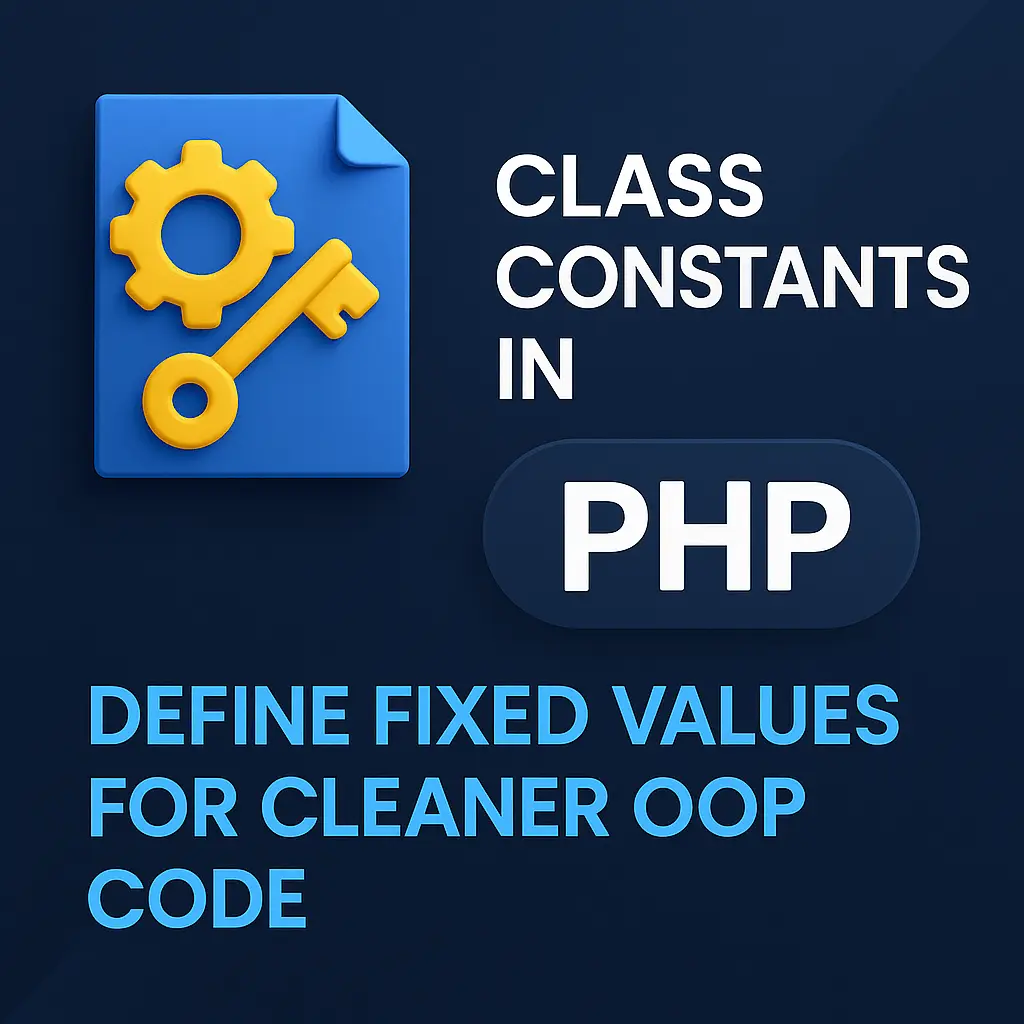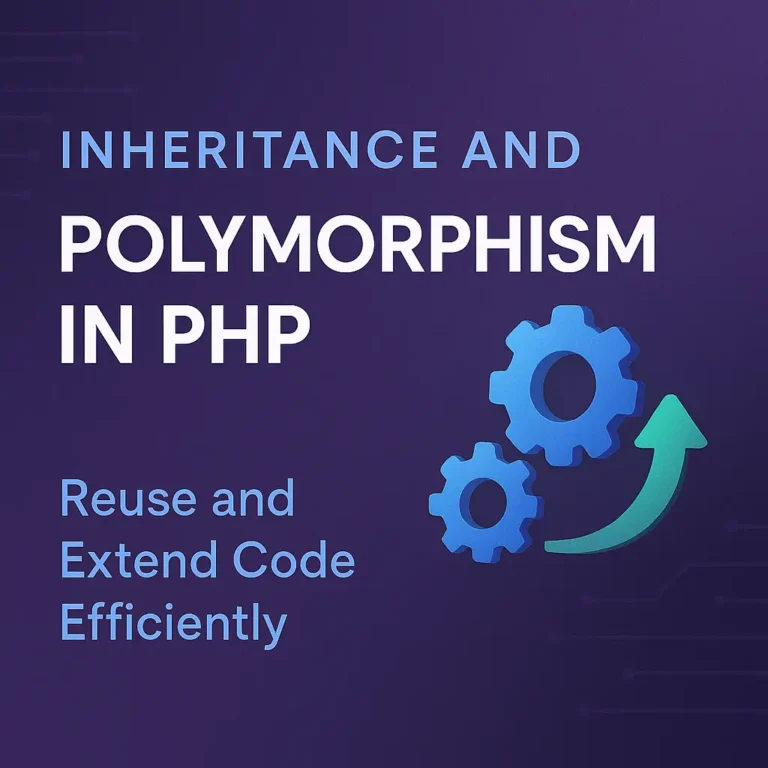In this article, we will explore how to declare and access class constants in PHP, with practical examples to illustrate their usage.
Declaring Class Constants
What are Class Constants?
Class constants are similar to regular constants defined using the define() function, but they are scoped within a class. This means they can be accessed using the class name rather than creating an instance of the class. Class constants are defined using the const keyword.
Declaring a Class Constant
To declare a class constant, use the const keyword followed by the constant name and value. By convention, constant names are typically written in uppercase letters with underscores separating words.
Example: Basic Class Constant Declaration
class Config {
const VERSION = '1.0.0';
const MAX_USERS = 100;
const BASE_URL = 'https://example.com';
}
In this example, the Config class defines three constants: VERSION, MAX_USERS, and BASE_URL. These constants are fixed values that cannot be changed.
Visibility of Class Constants
Class constants are always public and their visibility cannot be changed. They can be accessed outside the class without any restrictions.
Using Class Constants in Methods
Class constants can be used within class methods. This is particularly useful for defining default values or conditions based on these constants.
Example: Using Constants in Methods
class Config {
const VERSION = '1.0.0';
const MAX_USERS = 100;
public function getVersion() {
return self::VERSION;
}
public function isUserLimitReached($currentUsers) {
return $currentUsers >= self::MAX_USERS;
}
}
$config = new Config();
echo $config->getVersion(); // Output: 1.0.0
echo $config->isUserLimitReached(101) ? 'Yes' : 'No'; // Output: Yes
In this example, the getVersion method returns the VERSION constant, and the isUserLimitReached method uses the MAX_USERS constant to check if the user limit has been reached.
Accessing Class Constants
Class constants can be accessed using the class name followed by the scope resolution operator (::) and the constant name. You do not need to create an instance of the class to access its constants.
Accessing Constants Outside the Class
Example: Accessing Constants
class Config {
const VERSION = '1.0.0';
const MAX_USERS = 100;
const BASE_URL = 'https://example.com';
}
echo Config::VERSION; // Output: 1.0.0
echo Config::MAX_USERS; // Output: 100
echo Config::BASE_URL; // Output: https://example.com
In this example, the constants VERSION, MAX_USERS, and BASE_URL are accessed directly using the class name Config.
Accessing Constants Inside the Class
Within the class, constants can be accessed using the self keyword followed by the scope resolution operator.
Example: Accessing Constants Inside the Class
class Config {
const VERSION = '1.0.0';
const MAX_USERS = 100;
public function displayConstants() {
echo 'Version: ' . self::VERSION . "\n";
echo 'Max Users: ' . self::MAX_USERS . "\n";
}
}
$config = new Config();
$config->displayConstants();
// Output:
// Version: 1.0.0
// Max Users: 100
In this example, the displayConstants method accesses the VERSION and MAX_USERS constants using the self keyword.
Constants in Subclasses
Class constants are inherited by subclasses. You can access the parent class constants using the parent keyword or directly via the subclass if not overridden.
Example: Inheriting Constants
class ParentClass {
const GREETING = 'Hello from Parent';
}
class ChildClass extends ParentClass {
const GREETING = 'Hello from Child';
public function showGreetings() {
echo parent::GREETING . "\n";
echo self::GREETING . "\n";
}
}
$child = new ChildClass();
$child->showGreetings();
// Output:
// Hello from Parent
// Hello from Child
In this example, ChildClass overrides the GREETING constant. The showGreetings method demonstrates how to access both the parent class and the subclass constants.
Practical Use Cases
Configuration Values
Class constants are ideal for defining configuration values that remain unchanged throughout the application.
class AppConfig {
const DB_HOST = 'localhost';
const DB_NAME = 'my_database';
const DB_USER = 'root';
const DB_PASS = 'password';
}
echo 'Connecting to database ' . AppConfig::DB_NAME . ' at ' . AppConfig::DB_HOST;
// Output: Connecting to database my_database at localhost
Status Codes
Constants can be used to define various status codes or states in an application.
class HttpStatus {
const OK = 200;
const NOT_FOUND = 404;
const INTERNAL_SERVER_ERROR = 500;
}
function getHttpStatusMessage($code) {
switch ($code) {
case HttpStatus::OK:
return 'OK';
case HttpStatus::NOT_FOUND:
return 'Not Found';
case HttpStatus::INTERNAL_SERVER_ERROR:
return 'Internal Server Error';
default:
return 'Unknown Status';
}
}
echo getHttpStatusMessage(HttpStatus::OK); // Output: OK
echo getHttpStatusMessage(HttpStatus::NOT_FOUND); // Output: Not Found
Role-Based Access Control
Class constants can be used to define user roles within an application, making it easy to manage permissions.
class UserRoles {
const ADMIN = 'admin';
const EDITOR = 'editor';
const VIEWER = 'viewer';
}
function getUserRoleMessage($role) {
switch ($role) {
case UserRoles::ADMIN:
return 'User has administrative privileges.';
case UserRoles::EDITOR:
return 'User can edit content.';
case UserRoles::VIEWER:
return 'User can view content.';
default:
return 'Unknown role.';
}
}
echo getUserRoleMessage(UserRoles::ADMIN); // Output: User has administrative privileges.
echo getUserRoleMessage(UserRoles::VIEWER); // Output: User can view content.
Conclusion
Class constants in PHP are a powerful feature for defining fixed, immutable values that are relevant to a class. They enhance code readability and maintainability by providing a clear and concise way to define and access these values. By using the const keyword, you can declare class constants that are accessible both inside and outside the class without the need to instantiate the class.
Understanding how to declare and access class constants, as well as their practical use cases, can significantly improve the structure and reliability of your PHP applications. Whether for configuration settings, status codes, or user roles, class constants offer a robust solution for managing fixed data within your code.






